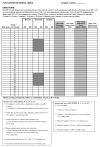Post-radiation dental index: development and reliability
- PMID: 18196283
- PMCID: PMC2709672
- DOI: 10.1007/s00520-007-0393-x
Post-radiation dental index: development and reliability
Abstract
Goals of the work: The aim of this paper was to develop, validate, and assess the reliability of a clinical index for assessing post-radiation dentition breakdown.
Materials and methods: An expert panel of four dentists with expertise in post-radiation patient care, oral radiology, and mineralized tissues reviewed a series of clinical photographs (n = 60) depicting a wide range of post-radiation lesions varying in size, severity, and location. Based on panel input related to lesion severity rankings and cut-points along a continuum of destruction, a semiquantitative, ordinal lesion scale was developed. A companion scale was developed to account for existing restorations. The index was then reviewed by a separate panel of dental clinician/researchers for confirmation of face and content validity and was refined based on their input. Following index approval by the expert and confirmatory panels, the index was evaluated for test-retest reliability by two educator/clinicians. After a brief calibration session, examiners reviewed and independently scored a second series of lesion images (n = 60). One week later, the same examiners independently scored the same images displayed in a different order. Inter- and intra-rater reliability and agreement were assessed (Spearman r and Kappa statistic).
Main results: Respective to sessions 1 and 2, inter-rater reliability values were r = 0.97 and r = 0.98, with Kappa values of kappa = 0.93 and kappa = 0.95. Respective intra-rater reliability and agreement values were 0.99 and 0.98 (rater 1), and 0.98 and 0.95 (rater 2).
Conclusions: A new index was developed and subsequently demonstrated face validity and excellent inter- and intra-rater reliability for potentially evaluating the severity of post-radiation dentition breakdown.
Figures
References
-
- American Cancer Society. What are the key statistics about oral cavity and oropharyngeal cancer? 2007. Available at http://www.cancer.org/docroot/CRI/content/CRI 2 4 1X What are the key statistics for oral cavity and oropharyngeal cancer 60.asp?rnav=cri.
-
- American Cancer Society. Oral Cancer. 2007. Available at www.cancer.org/downloads/PRO/OralCancer.pdf.
-
- Anne PR, Curran WJ., Jr A phase II trial of subcutaneous amifostine and radiation therapy in patients with head and neck cancer. Semin Radiat Oncol. 2002;12:18–19. - PubMed
-
- Anneroth G, Holm LE, Karlsson G. The effect of radiation on teeth. A clinical, histologic and microradiographic study. Int J Oral Surg. 1985;14:269–274. - PubMed
-
- Beumer J, Curtis TA, Nishimura R. Prosthodontic Procedures: Complete Dentures. In: Beumer J, Curtis TA, Marunick MT, editors. Maxillofacial Rehabilitation: Prosthodontic and Surgical Considerations. Ishiyaku EuroAmerica, Inc; St. Louis: 1996. pp. 101–102.
Publication types
MeSH terms
Grants and funding
LinkOut - more resources
Full Text Sources
Research Materials



